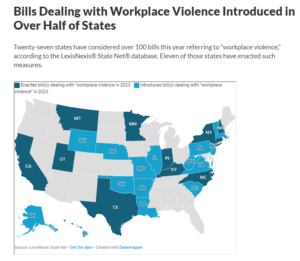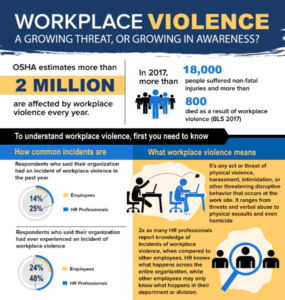Interested in compliance with California Senate Bill 553? We’ve prepared resources to help you assess your current program or build a program from scratch that meets all the requirements. We’ve prepared a white paper and compliance checklist to help make sure you’re ready.
Workplace Violence Prevention
Our approach to workplace violence prevention programs includes a full suite of materials to help your organization be ready to identify risks, train your employees, establish a threat assessment group, and document every case to track trends over time. This service offering typically includes:
Initial Working Session: Kick off with the core project team and further define project materials and approach.
Assessment Grid and Triage Process: Review sample previous incidents. Conduct interviews with select team members. Review your incident documentation and case file system and suggest any needed changes. Create an assessment grid and triage process.
Program Documentation/Deliverables: Documentation solution for scalability across offices and business units.
4 Key Deliverables: 1. Facilitator Guide 2. WPV TAG Member Playbook 3. Quick Reference 4. WPV TAG Training Deck
Employee Training Script: Workplace Violence Prevention training script for employees. The script can be used to build LMS components by your training department, or we can provide a training PowerPoint (or Google Slides) that can be used.
Implementation: 4-6 weekly mini-tabletop exercises for program implementation and fine-tuning protocols or a single tabletop exercise for the entire team.
How We Define Workplace Violence
Any act of violence or threat of violence that occurs in a place of employment. This includes, as expected, verbal and written threats of violence and incidents involving the use of firearms or dangerous weapons, regardless of whether an employee sustains an injury.
However, the definition also captures acts such as a threat that results in or has a high likelihood of resulting in injury, psychological trauma, or stress, regardless of whether the employee sustains an injury.
Why You Need a Workplace Violence Program
Putting a compliant Workplace Violence Prevention program in place should be both a reflection of your organization’s culture and build upon your emergency management and crisis management systems.
Even if you don’t have a robust corporate security program, we can help you build a program that meets you where you are.


The Statistics About Workplace Violence Are Concerning
The premier industry group for Human Resources professionals actively tracks the threat of workplace violence. Read the report.
The findings from SHRM indicate that workplace violence is more common than might be expected.
“Threat assessment is a systematic, fact-based method of investigation and examination that blends the collection and analysis of multiple sources of information with published research and practitioner experience, focusing on an individual’s patterns of thinking and behavior to determine whether, and to what extent, a person of concern is moving toward an attack.
A threat assessment is not a final product but the beginning of the management process. It guides a course of action to mitigate a threat of potential violence; merely identifying that someone is of moderate or higher concern, without developing a management strategy, does not complete this process and is not recommended.
When a person of concern has been brought to the attention of safety stakeholders, it is essential to engage as early as possible in the assessment and management process. By the time crisis stage management is reached, likely solutions run the risk of being “knee jerk” rather than measured.
By engaging in the assessment and management process as soon as a person of concern is identified, threat managers are more likely to succeed in preventing a violent outcome. Steering a person in a different direction early on may mean offering assistance to someone who needs it before that person concludes violence is necessary.”
From “Making Prevention a Reality” by the Behavioral Analysis Unit of the National Center for the Analysis of Violent Crime